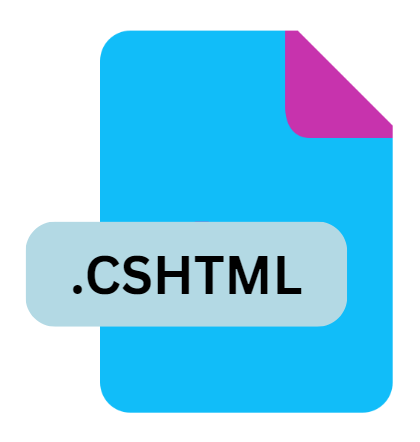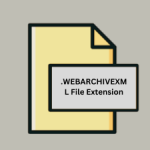.CSHTML File Extension

What is an CSHTML file?
The .cshtml file extension refers to a file format used in ASP.NET Razor, a view engine introduced by Microsoft as part of its ASP.NET framework. Razor is designed to simplify the creation of dynamic web pages using C# or VB.NET code within HTML markup.
The .cshtml files are fundamental in ASP.NET MVC (Model-View-Controller) and ASP.NET Core applications, providing a way to combine server-side code with HTML to render dynamic content.
More Information.
Razor was introduced as a more intuitive and lightweight alternative to ASPX pages. Prior to Razor, ASP.NET developers used Web Forms with .aspx pages, which required verbose syntax and more complex code-behind files.
Razor was designed to address these issues by integrating the code directly into the markup, thereby simplifying the development process. The .cshtml extension was chosen to denote Razor files using C# syntax, as opposed to .vbhtml for VB.NET syntax.
Initially, Razor’s purpose was to provide a better developer experience by enabling a more readable and maintainable code structure.
It allowed developers to write HTML and C# code in the same file without the need for extensive boilerplate code.
This integration facilitated the creation of dynamic web pages with greater ease, enhancing productivity and reducing the potential for errors.
Origin Of This File.
The .cshtml file extension originates from the Razor view engine, which was introduced by Microsoft in 2010 with ASP.NET MVC 3.
Razor aimed to improve upon the older ASPX view engine by offering a more streamlined and cleaner syntax for embedding server-side code in web pages.
Razor’s design philosophy emphasizes a minimalist approach, reducing the amount of code needed to achieve the same functionality.
The introduction of .cshtml was part of a broader effort to enhance web development practices within the ASP.NET ecosystem.
File Structure Technical Specification.
The .cshtml file is essentially a text file that combines HTML with embedded C# code. Its structure allows developers to seamlessly mix static HTML content with server-side logic. Here’s a breakdown of its typical structure and technical specifications:
- HTML Markup: The majority of the
.cshtmlfile contains standard HTML markup used to define the structure and layout of the web page. - Razor Syntax: Razor code blocks are embedded within the HTML using the
@symbol. For example,@DateTime.Nowwould insert the current date and time into the HTML output. - C# Code Blocks: Razor supports inline C# code blocks, which are enclosed in
@{ }braces. For example,@{ var message = "Hello, world!"; }initializes a C# variable that can be used within the HTML. - Helpers and Layouts: Razor also supports the use of HTML helpers and layout pages. HTML helpers are methods that generate HTML markup, while layout pages provide a consistent template for multiple views.
- Directives: Razor files can include directives that provide additional functionality or configuration. For example,
@modelis used to specify the type of the model being passed to the view.
The file is typically processed by the Razor engine at runtime, which compiles the .cshtml file into a C# class that generates the final HTML content sent to the client’s browser.
How to Convert the File?
The .cshtml file itself is not typically converted to another format directly. If you need to convert or migrate content, consider the following:
- To Static HTML: If you want to convert
.cshtmlcontent to static HTML, you can use a Razor view engine to render the.cshtmlfile to HTML and then save the output. - To Other Frameworks: Migrating
.cshtmlfiles to another framework involves translating Razor syntax into the corresponding syntax of the target framework. For instance, moving to a JavaScript-based framework might involve converting Razor code to JavaScript and adapting HTML structure. - To
.vbhtml: If you’re switching from C# to VB.NET, you can rewrite.cshtmlfiles with.vbhtmlsyntax, adjusting the Razor code blocks to VB.NET conventions.
Advantages And Disadvantages.
Advantages:
- Simplified Syntax: Razor’s syntax is cleaner and more concise compared to traditional ASPX pages, making it easier to read and write code.
- Seamless Integration: Razor allows for seamless integration of server-side code with HTML, reducing the need for separate code-behind files and simplifying the development process.
- Enhanced Maintainability: The combined code and markup in
.cshtmlfiles lead to more maintainable codebases, as developers can see both the HTML and C# code in a single file. - Improved Performance: Razor pages are compiled into C# code, which can enhance performance by reducing the overhead associated with runtime interpretation.
Disadvantages:
- Learning Curve: For developers accustomed to older ASP.NET Web Forms or other templating engines, there may be a learning curve associated with mastering Razor syntax and conventions.
- Limited to ASP.NET:
.cshtmlfiles are specific to the ASP.NET ecosystem. Developers working in different environments or frameworks may need to use other templating solutions. - Debugging Complexity: While Razor simplifies many aspects of development, debugging mixed HTML and C# code can sometimes be challenging, especially for complex pages.
How to Open CSHTML?
Open In Windows
- Visual Studio:
.cshtmlfiles can be opened and edited using Microsoft Visual Studio, which provides full support for ASP.NET development. - Visual Studio Code: This lightweight editor also supports
.cshtmlfiles with the appropriate extensions for syntax highlighting and code editing.
Open In Linux
- Visual Studio Code: On Linux, Visual Studio Code is a popular choice for editing
.cshtmlfiles, providing syntax highlighting and basic editing capabilities. - MonoDevelop: While not as feature-rich as Visual Studio, MonoDevelop can be used for basic editing of
.cshtmlfiles on Linux.
Open In MAC
- Visual Studio for Mac: This IDE offers support for
.cshtmlfiles, allowing macOS users to develop and edit Razor views. - Visual Studio Code: Similar to Windows, Visual Studio Code on macOS can be used to edit
.cshtmlfiles with the necessary extensions.













